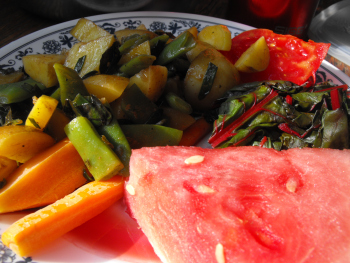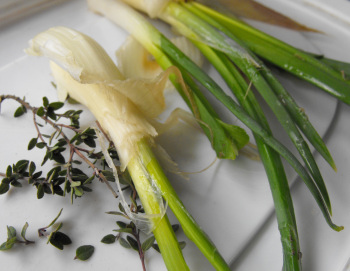
In-season cooking experiments
 If
the beginner
recipes in my last
post look boring to you, you're
probably ready to become an experimental, in-season chef. Most
cookbooks are chock full of fascinating recipes...which call for
ingredients from three different seasons per dish. Here are my
intermediate tips for learning to cook in season.
If
the beginner
recipes in my last
post look boring to you, you're
probably ready to become an experimental, in-season chef. Most
cookbooks are chock full of fascinating recipes...which call for
ingredients from three different seasons per dish. Here are my
intermediate tips for learning to cook in season.
First, start with the
ingredients. Rather than saying, "I feel
like lasagna tonight," take a look in the garden and see what's
ripe. Our recipes at the moment revolve around snow and sugar
snap peas, new potatoes, eggs, broccoli, greens, basil, and parsley,
which is why we've been making meals like pesto pasta with balsamic
vinegared greens and a fried egg on the side.
 Once
you know what you're cooking with, head to one of the recipe
websites like epicurious and type your
ingredients into the search
box. The website will spit out a whole string of recipes for you
to choose between.
Once
you know what you're cooking with, head to one of the recipe
websites like epicurious and type your
ingredients into the search
box. The website will spit out a whole string of recipes for you
to choose between.
Chances are, you still
won't have all of the ingredients required by a
recipe, so you should be willing to substitute for a more appropriate,
in-season vegetable or herb. Some of my favorite replacement
plants are Egyptian onions for leeks and parsley for celery since I can
harvest Egyptian onions and parsley for at least 11 months out of the
year.
Finally, some vegetables
are such good keepers that they can be
considered to almost always be in season. Bulb onions, potatoes,
garlic, and carrots are a few examples. You can add them to your
recipes with impunity.
| This post is part of our Beginner's Guide to Gardening and Eating in
Season lunchtime series.
Read all of the entries: |
Want more in-depth information? Browse through our books.
Or explore more posts by date or by subject.
About us: Anna Hess and Mark Hamilton spent over a decade living self-sufficiently in the mountains of Virginia before moving north to start over from scratch in the foothills of Ohio. They've experimented with permaculture, no-till gardening, trailersteading, home-based microbusinesses and much more, writing about their adventures in both blogs and books.
Want to be notified when new comments are posted on this page? Click on the RSS button after you add a comment to subscribe to the comment feed, or simply check the box beside "email replies to me" while writing your comment.

What do you do for storage? What do you leave in the ground till you eat it?
I've seen potatoes stored in saw dust or in lime powder (no rodents or other critters) and I've seen onions stored in dark closets.
When I was a kid 100 lbs. of potatoes didn't last long with a family of nine counts and no accounts, but big eaters, and when growing my two kids we didn't worry about storage, but just getting it to the table.
Soooooo...whats your take on storage, or grow less so you don't worry about it--LOL.
I understand canning (ummm JAM!) but storage is a bit bewildering to me.
You might want to check out our storage vegetables lunchtime series. We do a lot of freezing, but last year we also started trying to grow more storage vegetables that can be eaten fresh over the winter. We found that onions, garlic, butternut squash, and sweet potatoes store just fine in a cool kitchen, and the blight wiped out our potatoes so we didn't even try to store them. We put the carrots in the crisper drawer of the fridge since it was empty, covered them with a damp towel (that I kept redampening every week), and they kept until late winter, when we ate the last one.
I have high hopes that this year we will actually get potatoes, and that we will have excavated the refrigerator root cellar to put them in.